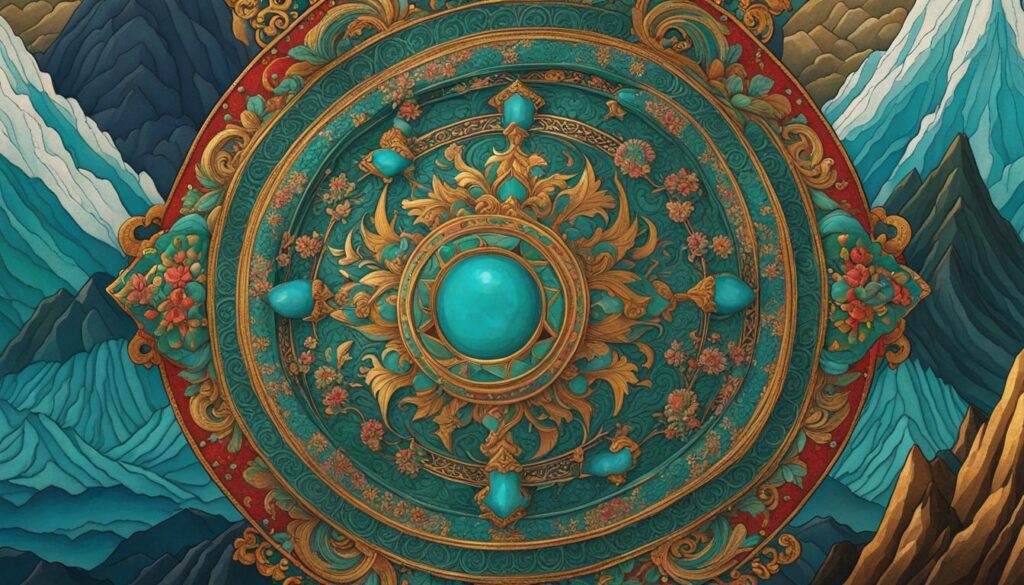Have you ever wondered where turquoise, that mesmerizing gemstone of vibrant blue and green, originates? In this article, we will delve into the origins of turquoise, exploring its mining locations and sources. Join us on this fascinating journey to uncover the secrets behind this precious gemstone.
Key Takeaways
- Turquoise has deep cultural significance in Tibet, symbolizing nobility and grandeur.
- Tibetans have been adorning themselves with turquoise for over 2,000 years.
- Turquoise is used in Tibetan Thangka art, adding vibrancy and symbolism to the paintings.
- In Tibetan medicine, turquoise is believed to have health benefits and is used as a guardian stone for overall well-being.
- Tibetan lakes, with their stunning turquoise blue color, are closely associated with the beauty of turquoise.
Turquoise’s Cultural Significance in Tibet
In Tibetan culture, turquoise holds a deep and revered significance. It is not only worn as a fashion statement but is also seen as a symbol of nobility and grandeur. The tradition of adorning oneself with turquoise dates back centuries, with historical accounts tracing its use to the coronation of the first Tibetan king. This gemstone has become intertwined with Tibetan traditions, reflecting the rich cultural heritage of the region.
One of the reasons turquoise holds such importance in Tibetan culture is its connection to nature. The vibrant blue color of turquoise is reminiscent of the turquoise blue lakes that dot the Tibetan landscape. These lakes are not only picturesque but are also considered sacred, symbolizing purity and tranquility. Turquoise’s association with these lakes, along with its use in Tibetan Thangka art, further enhances its cultural significance.
Additionally, turquoise is believed to have health benefits and is valued as a guardian stone in Tibetan medicine. It is thought to improve blood circulation and alleviate eye fatigue. In Tibetan medicine, wearing turquoise is seen as a protective measure for overall health and well-being. The belief in its healing properties further deepens the cultural significance of turquoise in Tibet.
Tibetan Traditions and Turquoise
“Turquoise has been a revered gemstone in Tibetan culture for centuries. Its association with nobility, nature, and health has made it an integral part of Tibetan traditions. From jewelry to art and medicine, turquoise holds a prominent place in the cultural tapestry of Tibet.”
From jewelry designs to Thangka paintings and traditional medicine, turquoise is deeply ingrained in Tibetan traditions. Its versatile malleability allows artisans to craft intricate jewelry pieces that reflect the rich cultural heritage of the region. The symbolism of turquoise in Tibetan art and its role in enhancing the beauty of Thangka paintings cannot be understated. Moreover, the affordability of turquoise in Tibet makes it accessible for individuals to own a piece of this cherished gemstone.
In conclusion, turquoise’s cultural significance in Tibet extends beyond its aesthetic appeal. It embodies the essence of Tibetan traditions, connecting people to their cultural roots and heritage. The reverence for turquoise in Tibet, with its symbolism, traditions, and healing properties, makes it a gemstone deeply embedded in the fabric of Tibetan culture.
Turquoise’s Role in Tibetan Thangka Art
Turquoise plays a vital role in Tibetan Thangka art, showcasing its enduring significance in Tibetan cultural and religious traditions. The use of turquoise pigment in Thangka paintings adds a unique and captivating element to these revered works of art. Skilled artisans grind turquoise to create a range of green shades, enhancing the overall beauty and symbolism in Thangka art.

The vibrant colors of turquoise bring life and vibrancy to the intricate detailing of Thangka paintings. This use of turquoise pigment represents the connection between spirituality and nature in Tibetan culture. It symbolizes the sacredness of water and the heavens, creating a visual representation of the deep spiritual beliefs held by Tibetans.
In Thangka art, turquoise is often used to depict Buddhist deities and divine beings, signifying their power and enlightenment. The rich green hues of turquoise contrast with other colors used in the paintings, creating a harmonious balance and drawing attention to the central figures. The inclusion of turquoise in Thangka art not only adds aesthetic beauty but also carries deep symbolic meaning, making it an integral part of Tibetan artistic expression.
Turquoise’s Role in Tibetan Medicine
In Tibetan Medicine, turquoise is highly valued for its believed health benefits. It is considered a guardian stone that promotes blood circulation and alleviates eye fatigue. Scientific research has validated the effectiveness of turquoise’s trace elements in improving blood circulation, reducing inflammation, and stopping bleeding. Wearing turquoise is seen as a protective measure for overall health and well-being in Tibetan Medicine, further cementing its importance in Tibetan culture.
The health benefits of turquoise have been recognized and utilized in Tibetan medicine for centuries. Turquoise is believed to have a positive impact on the cardiovascular system, helping to improve blood flow and regulate blood pressure. Its anti-inflammatory properties make it beneficial for conditions such as arthritis and joint pain. Turquoise is also known for its ability to calm the mind and alleviate stress, making it a valuable tool in promoting mental well-being.
In addition to its physical health benefits, turquoise is also considered to have spiritual and energetic properties. It is believed to balance and harmonize the chakras, promoting a sense of inner peace and spiritual growth. The vibrant blue color of turquoise is associated with the throat chakra, enabling clear communication and self-expression. This connection between turquoise and spiritual well-being further adds to its significance in Tibetan medicine and culture.
Turquoise in Tibetan Medicine: Practical Applications
“In Tibetan medicine, we use turquoise extensively to help our patients with various health issues. It is especially effective in treating disorders related to the heart and blood circulation. The trace elements present in turquoise have a remarkable impact on the body’s energy flow, promoting balance and harmony. Turquoise is also used externally, in the form of jewelry or as a powder applied to the skin, to enhance its healing properties.”
Turquoise’s role in Tibetan medicine goes beyond its physical and spiritual benefits. It is also used in practical ways to support healing and well-being. Turquoise is often incorporated into medicinal compounds, powders, and ointments, which are then applied to the body or consumed orally. The unique properties of turquoise make it a versatile and valuable ingredient in Tibetan medicine, contributing to the holistic approach to health and healing in the Tibetan culture.
The Blue Beauty of Tibetan Lakes
Tibet is home to numerous lakes that captivate visitors with their stunning turquoise blue color. These lakes hold deep significance in Tibetan culture and are closely associated with the precious gemstone, turquoise. The turquoise blue hue of these lakes varies depending on the depth of the water and the minerals present, creating a mesmerizing sight for all who behold them.
One of the most renowned turquoise blue lakes in Tibet is Yamdrok Lake. This breathtaking body of water showcases unique shades of blue that seem almost ethereal. Surrounded by snow-capped mountains and dotted with monasteries, Yamdrok Lake is a true natural wonder. Its turquoise blue color adds to the allure and mystique of the region, drawing visitors from far and wide to witness its beauty.
The significance of turquoise blue in Tibetan lakes goes beyond their visual appeal. In Tibetan culture, turquoise is believed to have protective and healing properties. The association of these lakes with turquoise further enhances their spiritual value and reinforces the deep connection between nature and Tibetan traditions.

The Significance of Turquoise Blue in Tibetan Lakes
“The turquoise blue color of Tibetan lakes is a reflection of the purity and serenity found in the natural world. It symbolizes the harmony between heaven and earth, the balance between the physical and spiritual realms.” – Tibetan proverb
The turquoise blue lakes of Tibet not only provide a feast for the eyes but also offer a serene and tranquil environment. They serve as a reminder of the beauty and power of nature, as well as the deep-rooted cultural and spiritual beliefs of the Tibetan people.
- The turquoise blue color of these lakes represents purity, calmness, and balance.
- It is believed to bring good fortune, protection, and positive energy.
- Turquoise blue lakes are considered sacred and are often sites for religious ceremonies and pilgrimages.
- The serene atmosphere of these lakes provides a space for reflection, meditation, and inner peace.
Visiting the turquoise blue lakes of Tibet is not only a visual delight but also an opportunity to connect with the rich cultural heritage and spiritual traditions of this enchanting land.
Tibetan Jewelry: A Reflection of Craftsmanship and Turquoise
Tibetan jewelry is renowned for its exquisite craftsmanship and the prominent use of turquoise gemstones. The combination of intricate designs and the vibrant blue hue of turquoise creates jewelry pieces that are not only visually appealing but also hold deep cultural significance. The artistry and attention to detail seen in Tibetan jewelry reflect the rich heritage and traditions of the region, making it a cherished form of adornment.
The use of turquoise in Tibetan jewelry is rooted in ancient traditions and beliefs. Turquoise is believed to possess protective and healing properties, making it an ideal gemstone for jewelry. The stone is often carved into various forms, including pendants, rings, bracelets, and necklaces, showcasing the versatility and malleability of turquoise. These jewelry pieces are often adorned with intricate silver, gold, or platinum work, further enhancing their beauty and craftsmanship.
Tibetan jewelry combines the elegance of turquoise with the skill of local artisans, resulting in stunning pieces that embody the essence of Tibetan culture and spirituality.
The Symbolism of Tibetan Jewelry Designs
Tibetan jewelry designs often incorporate elements inspired by the region’s rich cultural and spiritual traditions. Symbols such as the lotus flower, the endless knot, and the auspicious eight-spoked wheel are commonly featured in jewelry to represent purity, eternity, and spiritual awakening. These symbolic motifs, combined with the vibrant turquoise gemstones, create jewelry pieces that not only adorn the body but also carry profound meaning and blessings.
Whether it’s a delicate turquoise pendant or an intricately designed Tibetan turquoise bracelet, each piece of jewelry tells a unique story. The blend of craftsmanship, meaning, and the inherent beauty of turquoise makes Tibetan jewelry a cherished treasure that connects wearers to the rich cultural heritage of Tibet.
Buying Turquoise in Tibet
When it comes to purchasing turquoise in Tibet, enthusiasts are in for a treat. Not only is turquoise more affordable compared to other precious gemstones, but it also holds deep cultural significance in Tibetan traditions. The cost of turquoise varies based on factors such as age, color purity, and patterns, giving buyers a range of options to choose from.
To ensure a reliable purchase, it is recommended to buy turquoise from reputable jewelry stores that feature Tibetan or Nepalese craftsmanship. These stores often showcase stunning silver-inlaid turquoise jewelry, highlighting the artistry and skill of local artisans. By purchasing from these establishments, not only can buyers acquire a memorable and authentic souvenir, but they also support the livelihoods of skilled craftsmen.
Whether you’re looking for a striking pendant, a statement ring, or an intricately designed bracelet, the versatility of turquoise jewelry in Tibet is truly remarkable. Its unique malleability allows artisans to shape and carve turquoise into various forms, resulting in breathtaking creations. By choosing to buy turquoise in Tibet, buyers can experience the beauty of this precious gemstone firsthand, all while immersing themselves in the rich cultural heritage of the region.
The Value and Rarity of Turquoise
Turquoise, with its mesmerizing hues and cultural significance, holds both value and rarity in the gemstone market. The value of turquoise is determined by various factors, including its color, hardness, and origin. High-quality turquoise, characterized by minimal impurities and a vibrant matrix, is considered rare and highly sought after.
One contributing factor to the rarity of high-quality turquoise is the limited number of well-known mines, particularly in the southwestern United States. The closure of classic turquoise mines has further increased the scarcity of exceptional stones, making them even more valuable.
Beyond its aesthetic appeal, turquoise is also recognized as an investment opportunity. The rarity of high-quality turquoise, coupled with its enduring cultural significance, has attracted collectors and investors alike. As with any investment, it is essential to have a comprehensive understanding of the gemstone’s value and rarity to make informed decisions.
FAQ
Where does turquoise come from?
Turquoise can be found in various parts of the world, including Tibet, Egypt, Iran, Mexico, and the southwestern United States.
What is the cultural significance of turquoise in Tibet?
In Tibetan culture, turquoise holds deep cultural significance and is seen as a symbol of nobility and grandeur. It is also associated with nature and serves as a guardian stone for health in Tibetan medicine.
How is turquoise used in Tibetan Thangka art?
Turquoise pigment is often used in Tibetan Thangka paintings to add vibrant colors and symbolism. Skilled artisans grind turquoise to create a range of green shades, enhancing the overall beauty of these revered works of art.
What are the health benefits of turquoise in Tibetan medicine?
Turquoise is believed to promote blood circulation and alleviate eye fatigue in Tibetan medicine. Scientific research has validated its effectiveness in improving blood circulation, reducing inflammation, and stopping bleeding.
Why are Tibetan lakes associated with turquoise?
Tibet is home to numerous lakes known for their stunning turquoise blue color. The color of these lakes is closely associated with turquoise, adding to the natural beauty and allure of the region.
How is turquoise used in Tibetan jewelry?
Turquoise is a sought-after gemstone in Tibetan jewelry. Artisans shape and carve turquoise into various forms, such as pendants, rings, bracelets, and necklaces. It can also be combined with other materials like silver, gold, and platinum to create intricate designs.
Where can I buy turquoise jewelry in Tibet?
It is recommended to purchase turquoise jewelry from reputable jewelry stores in Tibet that feature Tibetan or Nepalese craftsmanship. These stores often sell silver-inlaid turquoise jewelry, supporting the livelihoods of skilled local artisans.
What is the value and rarity of turquoise?
High-quality turquoise with minimal impurities and well-colored matrix is considered rare and valuable. The closure of classic mines in the southwestern United States has increased the rarity of high-quality stones, making turquoise an investment target.




